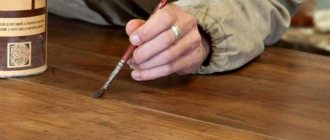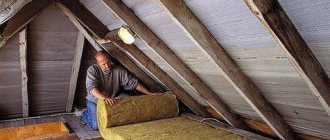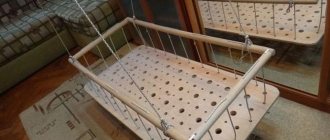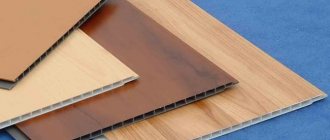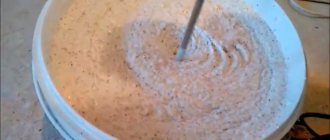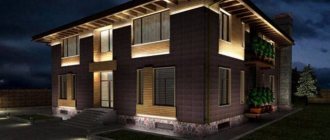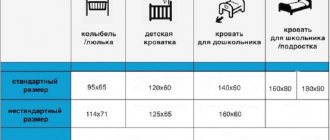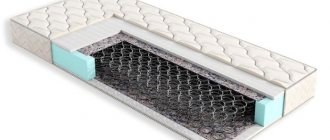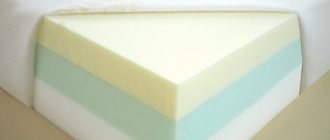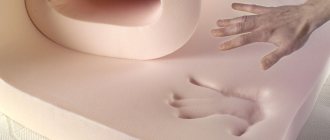Mattress size
It is important that the dimensions of the mattress (height, length and width) perfectly match the dimensions of the bed. If you are just about to purchase a bed, we recommend that you pay attention to the dimensions of the sleeping place (the inside of the bed) indicated in its description.
In this case, external dimensions do not matter. If you already have a bed, you need to measure its internal dimensions: width, length, height.
You will select a mattress based on these parameters.
p, blockquote 8,0,0,0,0 –>
After taking measurements, you will most likely get results that either correspond to standard mattress sizes or differ by a few centimeters.
p, blockquote 9,0,0,0,0 –>
Furniture and mattress manufacturers try to adhere to uniform standard sizes, so choosing the right size mattress does not cause problems. For an additional fee, which varies between 5-10%, we are ready to produce a mattress of non-standard sizes in increments of 5 cm according to your order.
Mattress length
The main rule when choosing a mattress is that the length should be 15 cm greater than your height.
p, blockquote 11,0,0,0,0 –>
Traditionally, the mattress has a length of 200 cm, which is a universal option for almost any height. If you are 175 cm tall, you will be quite comfortable on a mattress whose length is 190 cm. At the same time, there is an intermediate size of products - 195 cm.
Mattress width
It is customary to conventionally divide mattresses into single and double, focusing on width. Standard sizes of single mattresses: 80x190, 80x200, 90x190, 90x200. Standard sizes of one-and-a-half-size mattresses are 120x190, 120x200.
p, blockquote 13,0,0,0,0 –>
Double mattresses are products with a fairly large width from 140 to 200 cm (step - 20 cm).
p, blockquote 14,0,1,0,0 –>
The most popular standard mattress size for a double bed is 160x200 cm.
p, blockquote 15,0,0,0,0 –>
Expert opinion
Mikhailova Maria Vasilievna
Furniture store manager. Knows everything about comfort and interior design
Mattresses with a width of 180 and 200 cm are considered family mattresses. This is an option for families with small children. This mattress can accommodate dad, mom and baby.
p, blockquote 16,0,0,0,0 –>
Line of standard sizes of double mattresses: 140x190, 140x200, 160x190, 160x200, 180x190, 180x200, 200x200.
p, blockquote 17,0,0,0,0 –>
Mattress height
An orthopedic mattress should have a height (thickness) slightly greater than the internal height of the side of the bed. If the owner of the mattress weighs heavily, it is recommended to give preference to products with increased height.
p, blockquote 19,0,0,0,0 –>
Products with a small thickness of 2-10 cm are usually used as mattresses for sofas or mattress covers.
Mattresses for newborn babies
Choosing a mattress suitable for a newborn baby is a very responsible task. Fortunately, manufacturers have developed many new materials for filling and covering such mattresses. And almost all of them are hypoallergenic and natural. For example, coconut fiber and natural latex.
There are double-sided mattresses that use two fillers. So that you can turn the mattress over depending on the need. The most important thing in mattresses for newborns is their naturalness, ease of cleaning (it is better to use special removable covers), and maximum rigidity. And also the ideal ratio of the sizes of the crib and mattress in it.
If the bed and mattress do not match in size, then this will result in a number of inconveniences for the baby:
- If the mattress is smaller, there will be gaps between it and the sides, which can lead to injury;
- If the mattress is larger than necessary, it will develop lumps and depressions due to folds. And this can even cause serious harm to a fragile spine.
As a rule, cribs and mattresses for newborns come in standard sizes:
- 120x60,
- 120x65
- etc.
But there are other options.
Mattresses for children from 1 to 3 years old
Cribs for children who have reached one year old become a little larger, and accordingly, the mattresses in them “grow up.” Thus, the size of mattresses for sleeping places intended for children from one to three years old can already reach 140x70. However, naturalness and quality, a clear match in size of the bed and mattress are still very important.
The most preferred filler for such mattresses is natural latex. And the design is spring-type with independent springs no more than 14-15 centimeters high.
In any store you may be offered to purchase a product made of artificial latex. Of course, it will cost much less than the natural one. But you need to keep in mind that artificial latex cannot be called hypoallergenic. So it’s better to choose mattresses made from this material for older children. When it is known for sure that the baby does not have allergies.
As for coconut fiber mattresses, in the store you need to very carefully study the label on which the manufacturer indicates the composition of the filler. The fact is that absolutely natural coconut fibers are bound with synthetic substances during the manufacturing process of mattresses. The higher the percentage of such binders, the more dangerous the product becomes for the child. And in any case, before buying a mattress, you must accurately measure the crib so that the mattress “fits” into it perfectly.
Mattress sizes for teenage beds
As noted above, children often sleep in their children's beds until adolescence, but if the child is growing quickly or you are updating the furniture by making a fresh renovation in his room, then it is important to pay attention to the teenager's growth. If he is tall and continues to grow quickly, then the length of the mattress can be 190, 195 or 200 cm if you choose standard sizes.
Width – from 80 to 120 cm, as for standard single or one-and-a-half beds.
p, blockquote 33,0,0,0,0 –>
When choosing a mattress for a child and not finding the right size in the catalog that fits a child’s bed, do not forget that you can always make an individual order. But the cost of a mattress made to individual sizes is usually slightly higher than a standard one.
p, blockquote 34,0,0,0,0 –>
Good luck with your choice and healthy sleep for your child!
p, blockquote 35,0,0,0,0 –>
Author of the article Natalya Galuzinskaya, especially for “DveMama.ru”
p, blockquote 36,0,0,0,0 –>
Selection by size
The sizes of mattresses for children are always chosen according to the size of the crib. If you're changing your bed because your baby has grown, it's time to get a new mattress. You must have the parameters of the future purchase, its length, width and even height. Everything matters, so measure the crib base first. The future product must fit perfectly into the base, without leaving empty space or, conversely, without tipping over the edge.
This element of a sleeping place is bought for several years until the baby grows up. Of course, you can buy a model for growth, but the crib must also be extendable. If you are of the same age and they sleep together, you should give preference to a double mattress.
The size of mattresses plays a key role in the correct formation of the spinal column, therefore, this point cannot be ignored. By choosing the right size, you will help your children get the full and healthy sleep necessary for their growing bodies.
Manufacturers offer three size options, and it’s not difficult to figure out which one will suit your case.
Following the table, it is easy to determine the right size. As a rule, cribs are produced with similar parameters, but if suddenly your baby’s crib does not meet the standard, the mattress for it can be ordered individually. But then make sure that it is hard enough, especially at the edges, choose a dense, ventilating filler, and that the surface is not irritating to the skin.
When placing the mattress on the base of the crib, pay attention to the distance between them. The optimal distance is considered to be no more than 3 cm, while the lounger itself can be more than 10 cm high.
| Mattress length in centimeters | Child's age |
| 120 | Up to 7 |
| 140 | 7-12 |
| 160-180 | 12-16 |
What sizes of mattresses are there?
If we talk about the width and length of the mattress, they are usually divided into:
- Single (width from 70 to 90 cm, length up to 200 cm and above);
- One-and-a-half (width from 110 cm, length up to 200 cm and above);
- Double (width from 140 cm, length up to 200 cm and above).
p, blockquote 38,0,0,0,0 –>
Knowing the exact size of your sleeping area (mattress or bed) will help you quickly and confidently choose a quality mattress that will definitely suit you. After all, if the mattress is smaller than the sleeping area of the bed, it will move and cause discomfort during rest.
Conversely, a larger mattress will bulge and negate all orthopedic properties.
p, blockquote 39,0,0,0,0 –>
Depending on the number of people sleeping, the size of the bedroom and other individual factors, the size of the bed and mattress is selected.
p, blockquote 40,0,0,0,0 –>
Also, you should pay attention to the height of the future sleeping place.
- The standard height for spring models is 5-17 cm.
p, blockquote 41,0,0,0,0 –>
The principle of choice is based on the fact that the mattress is higher than the side of the bed.
Mattresses for children's beds
All factory furniture has standard sizes, so purchasing a mattress for a bed will not be difficult. It is only important to know that the height of the mattress can also be different:
- for newborns, it is better to choose mattress models with a height of at least 10 cm, preferably double-sided, to ensure better ventilation;
- For preschoolers and schoolchildren, it is better to buy a bed with a deep bed, and a mattress with a thickness of 20-25 cm.
When ordering a car bed or other non-standard model for a child, be guided by the standard dimensions of the sleeping place so that you can easily buy a mattress for it later.
The video provides important tips for choosing a mattress for a child or teenager
Currently, an IKEA “Vissa Somnat” growing mattress has been developed for children for a growing crib. It consists of three parts: two measuring 35x80 cm, one 130x80 cm, all 10 cm thick, each part is packed in a separate case. The mattress is made from high-quality materials: latex, polyester wadding filling, breathable cover. First, one, largest part of the growing mattress is used for the child; as the child grows, a second part is added, then another third part. Reviews of the growing mattress are positive, the disadvantage is the high cost.
When buying a bed for a child, it is important to choose the right mattress for it. One of the selection parameters is the size of the mattress, and it is important to know how to determine it correctly. The basic rule for choosing a mattress is that its length should be 20-50 cm longer than the child’s height. A correctly chosen mattress will provide your child with healthy sleep and posture.
Non-standard mattresses to order in St. Petersburg
We sew mattresses to order according to customer sizes in St. Petersburg.
- You indicate:
- mattress length
- mattress width
- mattress height
- Make an advance payment.
- We make a custom-made cotton wool mattress for you according to your dimensions within 7 days.
- We deliver your custom-made mattress to a pick-up point or to your home.
h3 10,0,0,0,0 –>
You can order a cotton mattress of absolutely any size!
We will be happy to make for you a custom-made children's mattress from cotton wool; we will make custom-made mattresses for a sofa, couch, ottoman or any other furniture, including a mattress for a crib.
p, blockquote 58,0,0,0,1 –>
We will make custom teak mattresses from cotton wool in non-standard sizes to suit every taste, for example, cotton wool mattresses 200x200, 180x200, 160x200, 140x200, 80x200, in general, sewing custom-made cotton mattresses of absolutely any size!
Inexpensive and economy models
And although the cost of coconut and coconut-latex mattresses for newborns is not that high, many parents are looking for more budget-friendly mattresses. Among these, children's mattresses made of holofiber and polyurethane foam have become widespread (read about the comparison of artificial and natural latex). However, we do not recommend using them from birth due to the unsuitable rigidity of these materials. If you really want to save money, then such mattresses can be recommended for use for children aged 2 years and older.
Standard sizes of children's mattresses - do they exist?
The choice of children's mattress size depends on age. We made a small “cheat sheet”:
| Age | Newborn | 1-3 years old | 3-7 years | 7-12 years | Teenager |
| Dimensions | 60Х120, 65Х125 | 70Х140, 80Х150 | 80Х160, 80Х170 | 90Х170, 90Х180 | 90Х190, 90Х200 |
It is worth noting that first a bed is purchased for the child’s age, and then a mattress is selected for this bed. If you already have a crib, focus primarily on the geometric parameters of the sleeping place in it.
It wouldn’t hurt to take a centimeter or tape measure and measure the exact length and width. This is necessary so that the mattress manufacturer can produce a perfectly suitable mattress for the crib.
Then it will neither stand on end nor dangle on the base. This is important especially for children, since their sleep is very sensitive, and any inconvenience can lead to constant awakenings.
How to choose a mattress for a child?
When buying a mattress for a child, the main thing is to choose the right firmness. The older the baby gets, the softer his sleeping place should become.
Sizes of children's mattresses
- For newborns
: 60x120 cm, 65x125 cm. - For 3-7 years
: 70x140, 70x160 cm. - From 8 years
: standard single mattresses 80 or 90 cm wide and 190 or 200 cm long.
Children's mattresses for newborns - from 0 to 2 years
Newborns
are recommended to buy very hard springless mattresses made from coconut coir. The fact is that until two or three years of age, the child’s spine is straight, the natural curve is just being formed. On a soft mattress, fragile muscles and skeleton do not receive sufficient support, and curvature is possible. Infants simply do not need innerspring mattresses. But high-quality rigid coconut springless models contribute to the correct formation of the baby’s musculoskeletal system and ensure the correct position of the body during sleep.
A child should sleep on a hard mattress until at least one and a half to two years of age.
. Next, you can select medium-hard models.
Universal double-sided children's mattresses save great money. For this age, you can choose from sides of different hardness - coconut and latex. The baby sleeps on the hard coconut side until one and a half to two years, and after that the mattress is turned over to the softer side. The mattress should be turned over only after reaching the required age and if discomfort occurs (the child falls asleep worse, tosses and turns, or wakes up frequently).
Children's mattresses for children 3 - 7 years old
Children from 3 to 7 years old
are already more demanding about the comfort of their cribs and are reluctant to fall asleep on too hard mattresses. At the same time, the curve of the spine in the cervical region is still developing, and soft models can be harmful to posture. Therefore, not very thick mattresses of medium hardness are more suitable for children aged 3-7 years. These can be either springless latex or combined (coconut + latex), as well as spring models.
It is important to consider that children 3-7 years old love to jump, tumble, and play on mattresses. Accordingly, the selected model must be resistant to such loads without loss of orthopedic properties. From this point of view, a high-quality mattress with a block of Bonnell dependent springs would be an excellent solution. Such models easily tolerate non-standard loads. Although good springless mattresses made from natural and artificial latex can be no less durable.
Children's mattresses from 7 to 12 years
For children from 7 to 12 years old,
sound sleep is no less important than for newborns. At night, the child regains strength for study and active games, so he should be absolutely comfortable on his mattress. The formation of the spine in the lumbar region continues until the age of 12, and children still need a medium-hard mattress that supports physiological processes. However, the thickness of the model should already be noticeably greater.
The best option for children 3-7 years old is a medium-hard thick springless mattress made of natural or artificial latex, as well as mattresses with a block of Bonnell dependent springs or with independent springs.
Mattresses for teenagers
Teenagers over 12 years of age are especially sensitive to stress on the spine as a result of sitting for long periods of time in class or at the computer. Therefore, at night it is advisable to let your back relax as much as possible. A mattress for a child over 12 years old should be anatomical and individually selected, quite hard, but comfortable.
Springless polyurethane foam mattresses with a thickness of 14 cm or more are ideal, as well as mattresses with independent springs that precisely adapt to the shape of the sleeper’s body and provide excellent back support.
In addition to the above, when choosing a mattress, you should pay attention to environmental friendliness and hypoallergenic materials. Mattresses for newborns should be easy to dry and ventilate, allow air to pass through and retain their shape. The size of the mattress is selected according to the size of the crib. Choose a children's mattress
Why can't I order a mattress without exact measurements?
Expert opinion
Mikhailova Maria Vasilievna
Furniture store manager. Knows everything about comfort and interior design
In our country, the very old GOST 19301.3-94 applies to the geometric parameters of beds. It does not correspond to modern life and defines only 2 children's sizes: 60X120 and 60X140.
Other meanings in the understanding of GOST are non-standard. Manufacturers of cribs made a decision: since GOST does not specify a sufficient set of geometric parameters anyway, it makes sense to produce those values that are technologically convenient for them.
Therefore, each bed manufacturer has different ones. For this reason, children's mattress factories produce any size to suit the client's crib - without additional payments or extended deadlines.
How to choose a mattress for a crib next?
After you have decided on the length and width of the sleeping place, you need to choose the composition of the mattress. We have prepared a simple table for you with factors that are worth paying attention to:
| Age | Newborn | 1-3 years old | 3-7 years | 7-12 years | Teenager |
| Rigidity | hard | hard | moderately hard, medium | moderately hard, medium | moderately soft, medium |
| Filling and thickness | coconut, strutto, holofiber 6-8cm | coconut, strutto, holofiber 6-8cm + latex (natural or artificial), 6-12cm | alternating layers of latex and coconut, 10-12cm | spring block, alternating layers of latex and coconut, 14-16cm | PPU or blocks of independent springs with latex and coconut fillers, from 16 cm high |
Sizes of children's mattresses for beds for children: table
Complete rest for a body tired during the day is possible only in the most relaxed position. Only a truly high-quality mattress can provide this level of comfort.
Long gone are the days of identical cotton mattresses with the obligatory strings. The range of modern textile industry successfully offers more and more new, fundamentally new models of orthopedic mattresses.
Such a sleeping surface will allow the body to completely relax, relieving the strain on each muscle. When choosing such a sleeping miracle, you need to follow simple rules, especially paying attention to the material used and the optimal size of the mattresses.
What should you pay attention to when choosing a mattress?
Right size
A mattress intended for baby sleep must match the dimensions of the selected crib. If it turns out to be smaller than the perimeter of the crib, it will constantly move out and cause inconvenience to the child during sleep. When choosing a mattress, pay attention to the size of the crib bed, and not to its external dimensions. Standard cribs presented on the Russian market usually have bed dimensions of 120*60 cm.
High hygiene and safety
A newly born baby will spend a lot of time in his crib, which means his mattress should be well ventilated and have a removable cover that is easy to remove and wash. The filler also plays an important role. The mattress must maintain a constant shape, the material itself should not smell and should not absorb foreign odors. The design must be breathable - this is a guarantee that no one will want to get caught in the mattress, and it should not absorb moisture. Naturally, the materials must be hypoallergenic and environmentally friendly. They should not become dusty or rot, and should be resistant to fungus.
You should also pay attention to the cover, which is mainly made of cotton fabric. For a newborn, it is important that the cover in places of contact with the body is free of rough seams, snakes and other parts that can cause discomfort to the baby during sleep.
To protect the mattress from dust, you can purchase a mattress cover. And the waterproof mattress covers now offered also protect against the inevitable “children’s surprises.” Typically, mattress covers are made in the form of a cover with an elastic band; it is easy to remove and wash.
Good orthopedic properties
We are not talking about treating an already formed curvature of the spine, but only about ensuring that the mattress for a newborn has sufficient rigidity. Then the spine of the little toddler will take a natural position during sleep. Pediatricians categorically do not advise children to sleep on a surface that is too soft, since in this case the fragile spine may become deformed.
Types of fillers
When studying the issue of choosing a children's mattress for a crib, you need to pay more attention to the filling option of the product. Pediatric experts say that in the early stages of a baby's development, the skeletal framework is formed and strengthened.
To avoid problems in the future, you need to choose a really good mattress; it’s better to spend more than once than to regret it later.
It is recommended to select filler from materials such as:
- Coconut coir. This is a completely natural product that is obtained by processing coconut fiber. The filler is quite hard and is able to create the necessary conditions for the flow of air and moisture. Does not absorb unpleasant odors, does not absorb water well. If we talk about expensive stuffing, then natural impregnation is used for production. Cheap models may use substances that are unsafe for children.
- Latex. It is also a natural element obtained from the sap of the Hevea plant. In some situations it can cause an allergic reaction; it is quite elastic, but softer than coir. The best solution would be a product that combines coconut and latex.
- Polyurethane foam. This is a tougher version of foam rubber. It can last a very long time, is safe, and provides the necessary passage of air and moisture. It lights up poorly and is used in the manufacture of orthopedic models.
- Struttofiber. This element does not cause allergies; it is produced using the press of natural and synthetic components. Excellent for use in winter - retains heat very well.
On video: how to choose a children's mattress.
Fillings for children's mattresses
The softness, hardness, elasticity, and safety of the product specifically for children depend on the filler of orthopedic mattresses. Mattresses for little ones should be made from high-quality natural materials. But if a child is susceptible to allergies, then some natural materials can cause an undesirable reaction in him, and in this case, no less high-quality artificial fillers will come to the rescue.
In any case, the fillings of children's mattresses should not have harmful fumes, caking, and must maintain the qualities declared by the manufacturer throughout the entire period of service. The most popular materials for filling children's mattresses are coconut fiber, polyurethane foam, and natural latex.
Orthopedists and pediatricians assure that a coconut mattress for a child is a guarantee of proper growth of the skeletal system and the full development of the child’s body
. Let us clarify that the name “coconut mattress” does not always mean that it is made from coconut coir alone. In a high-quality coconut mattress, a proven design is combined with fillers selected exactly for the intended purpose of this product. A coconut children's mattress from good manufacturers will evenly distribute the load on the spine and ensure a restful sleep for the child.
Coconut fiber contains lignin, a natural polymer that gives it elasticity, protects it from rotting and does not allow it to absorb moisture. In addition, coconut mattresses are perfectly breathable and ventilated, which guarantees that the microclimate inside the mattress is correct. Coconut coir is hypoallergenic, which means it is safe for children.
Note that coir can be different. Products with shredded coconut coir are cheap, but after a couple of months you may notice that the mattress has gone into “waves.” To protect yourself from counterfeits and low-quality products, do not buy dubious products from fly-by-night manufacturers, purchase a proven coconut mattress for your baby with all hygienic reports and quality certificates.
Latex
- This is a high-quality natural material. It is obtained from the sap of the tropical Hevea tree. Natural latex has a cellular structure, thanks to which it springs perfectly and restores its original shape. This material structure also provides it with excellent ventilation and air permeability. Latex is endowed with hypoallergenic, antifungal and antibacterial properties; it does not absorb moisture, does not absorb dust and does not rot. Micro-mites do not form in latex; its ability to retain and quickly restore its shape makes latex an excellent orthopedic filler for children's mattresses.
Coconut mattresses with latex
have medium hardness. Such mattresses for children are not only comfortable, but also hygienic. Latexed coconut coir is made from more expensive and high-quality raw materials. To briefly describe the process, coconut fibers are compressed and impregnated with natural latex, after which a durable, dense and elastic material is formed. A coconut mattress with latex filling exactly follows the contours of the human body, so this mattress will ensure your child a healthy, sound and deep sleep.
Polyurethane foam
, abbreviated as PPU, also known as artificial latex, was created with the aim of reducing the cost of natural latex. Of course, the latex analogue is not as good as expensive natural material, but it is still worth paying tribute to polyurethane foam and recognizing that in its properties it is very close to natural latex. Polyurethane foam does not cause allergic reactions, it is environmentally friendly and fireproof. Like latex, polyurethane foam has a cellular structure and each cell acts as a mini-spring. This material “breathes” freely, provides a good orthopedic effect of hardness/softness in the desired areas, protecting the child’s spine from curvature.
But what you should avoid are foam rubber or cotton mattresses
. These fillers are soft and not elastic enough, and they also absorb moisture well, creating a favorable environment for the development of bacteria. Cotton wool and foam rubber are easily dented and destroyed. On such a mattress, the baby will not receive proper orthopedic support. The only advantage of cotton and foam mattresses is their low cost. However, experts agree that it is better to add a little and buy the most budget-friendly coconut mattress. It will be much more useful for the child.
View the catalog of children's mattresses
Orthopedic mattresses for babies
Perhaps this is the best option for a newborn baby. The optimal choice would be a springless orthopedic model. Most quality products are equipped with one or more fillers. It happens that pressed horsehair is used as stuffing.
The manufacturing process uses a pattern of alternating soft and hard layers, which allows for better rigidity and elasticity of the sleeping bag. In infancy, such a mattress is placed on one side so that the child sleeps on the hard side. Then, when it grows, the product can be turned over to the soft side.
Main varieties
As already noted, it is not only compliance with the dimensions of the bed that determines the quality of the base for the bed. This product is available in several forms:
- orthopedic;
- spring;
- springless;
- hypoallergenic;
- with coconut filling.
When choosing between types of mattresses for children's beds, it is necessary to take into account both the age and characteristics of the child's body. In particular, for newborns it is recommended to purchase springless products with a hypoallergenic coating.
The quality of children's sleep depends on the characteristics of the bed base. In addition, these parameters influence the development of the child in the first years of life. Incorrectly selected bedding can lead to curvature of the spine, which in the future will require complex physiotherapeutic procedures.
Spring
Such models are also divided into several types. For children, it is recommended to buy mattresses with an interdependent spring block. You can check this nuance without removing the coating. To do this, press on one edge of the mattress. If the product is lifted from the second side, then each spring under the coating is connected to the others.
Buying such bedding is justified for teenagers. Despite the fact that spring models do not cause significant harm to the spine, it is not recommended to place these products in the beds of young children.
This recommendation is due to the fact that a child can move out of bed due to the fact that when pressure is applied, one edge of the mattress rises. There are also models that contain several springs, combined into separate blocks.
These products do not have the above disadvantage.
Springless
Springless models are divided into the following types:
- Latex. They are considered the best option for a children's bed. Latex models evenly redistribute the load on the spine, preventing sweating and the appearance of harmful organisms such as dust mites.
- Polyurethane foam. This synthetic material is based on natural ingredients. Polyurethane foam mattresses are characterized by good elasticity and ensure the correct position of the spine during sleep. Models of this type are hypoallergenic.
- Made from viscoelastic foam. Microporous material is able to “remember” the anatomical features of a person, thereby providing comfortable rest.
Some mattress models are equipped with additional layers made of different materials: biofoam (not recommended for children as it emits odors), flexfiber (able to retain its original shape) and spunbond. The latter is more often used in bedding with springs.
Orthopedic
Orthopedic mattresses are available with both springs and other fillers. In the latter case, additional layers are provided that redistribute the load along the entire length of the bed. Orthopedic mattresses are recommended for children of all ages. Such models are able to maintain the shape of the back during sleep without sagging over time.
Orthopedic mattresses are required for children who have been diagnosed with disorders in the development of the spine. Models without a spring block are considered optimal. This is explained by the fact that such products last up to 15 years.
Coconut
Coconut filler is breathable, does not collect dust or moisture, and does not cause an allergic reaction. The material is characterized by increased rigidity. Due to this, coconut filler is used in the manufacture of orthopedic mattresses.
Types of fillers in oval mattresses
Most oval pads do not have springs. The models are filled with special padding. The most popular fillers used in production are made from natural or synthetic materials.
Coconut filler
Coconut is a common filler used to stuff mattresses.
Its advantages:
- Environmental friendliness and the absence of an allergic reaction to coir in children.
- Optimal level of rigidity.
- High elasticity.
- No deformation during operation.
- Moisture resistance. Coconut filler does not absorb moisture, does not mold or rot.
- “Breathing” structure - allows you to create an ideal microclimate.
Pediatricians recommend bedding with coconut filling for newborn babies.
Hallcon
Among the advantages of such a filler as hallcon are:
- Hypoallergenic.
- No toxic substances in the composition.
- “Breathing” effect and no risk of mold, mildew, or dust mites.
- Fire properties. Hallcon fibers are non-flammable.
- No unpleasant odors.
- The material does not roll or deform.
- After use, the mattress immediately returns to its original shape and does not sag from physical impact.
- Antistatic effect. Hallcon does not accumulate static electricity.
- Low and high temperatures do not affect the filler.
The litter can not only be cleaned, but also washed and disinfected.
Latex
Latex padding has a large number of advantages. Among them:
- No allergies to the material.
- Sufficient orthopedic rigidity, which ensures correct alignment of the spine.
- Resistant to moisture and temperature changes.
- During use, the mattress does not deform and takes its original shape.
Latex filler meets all safety requirements, so it is often used as mattress padding.


